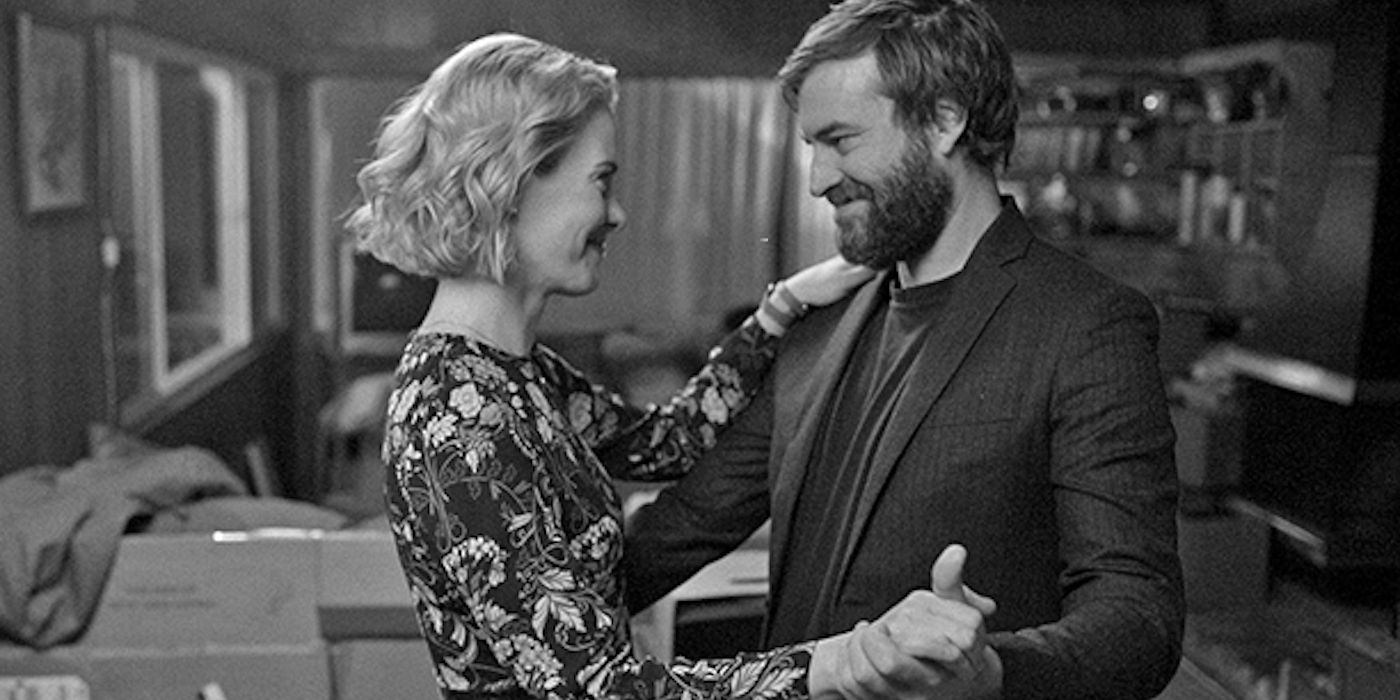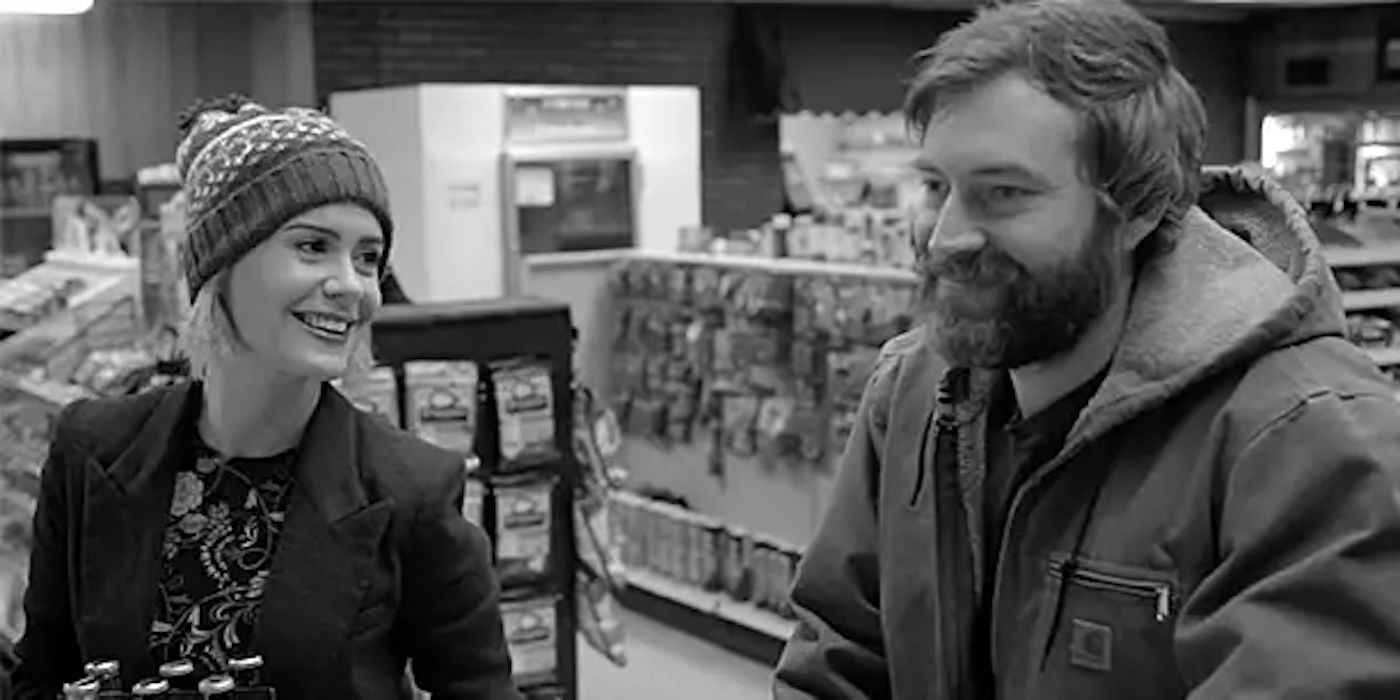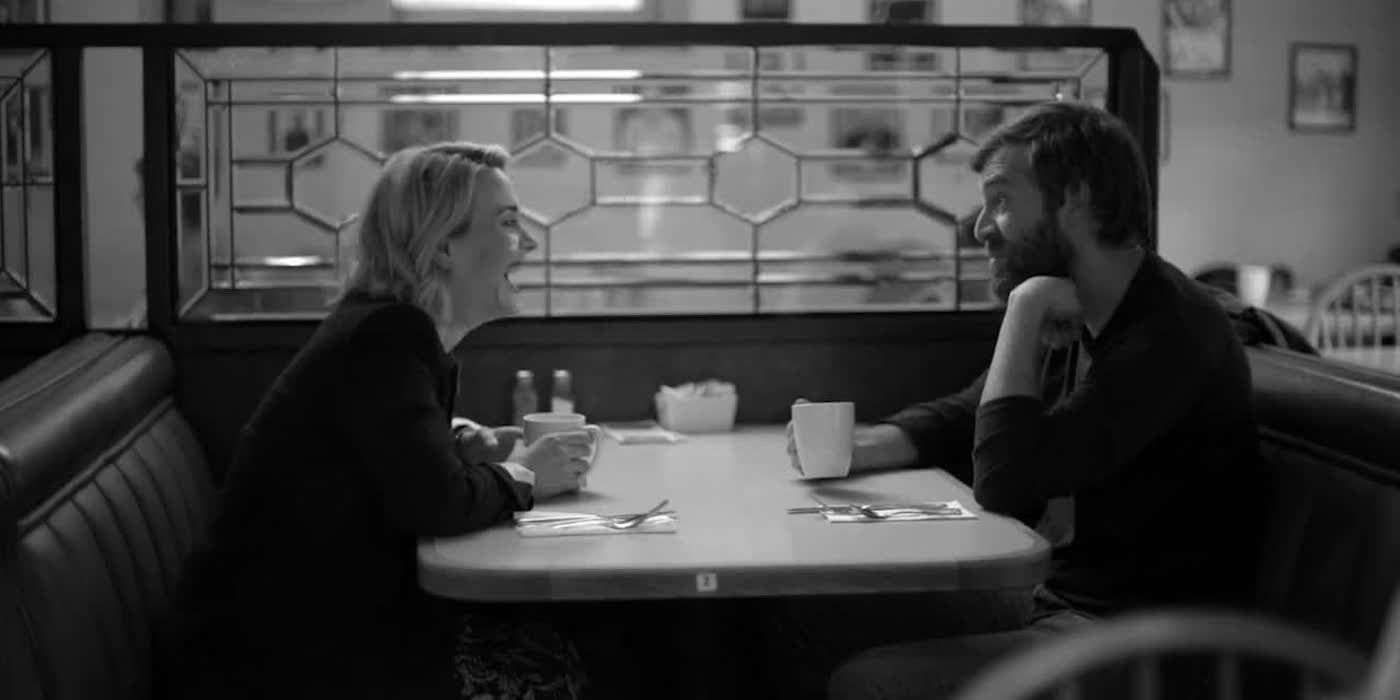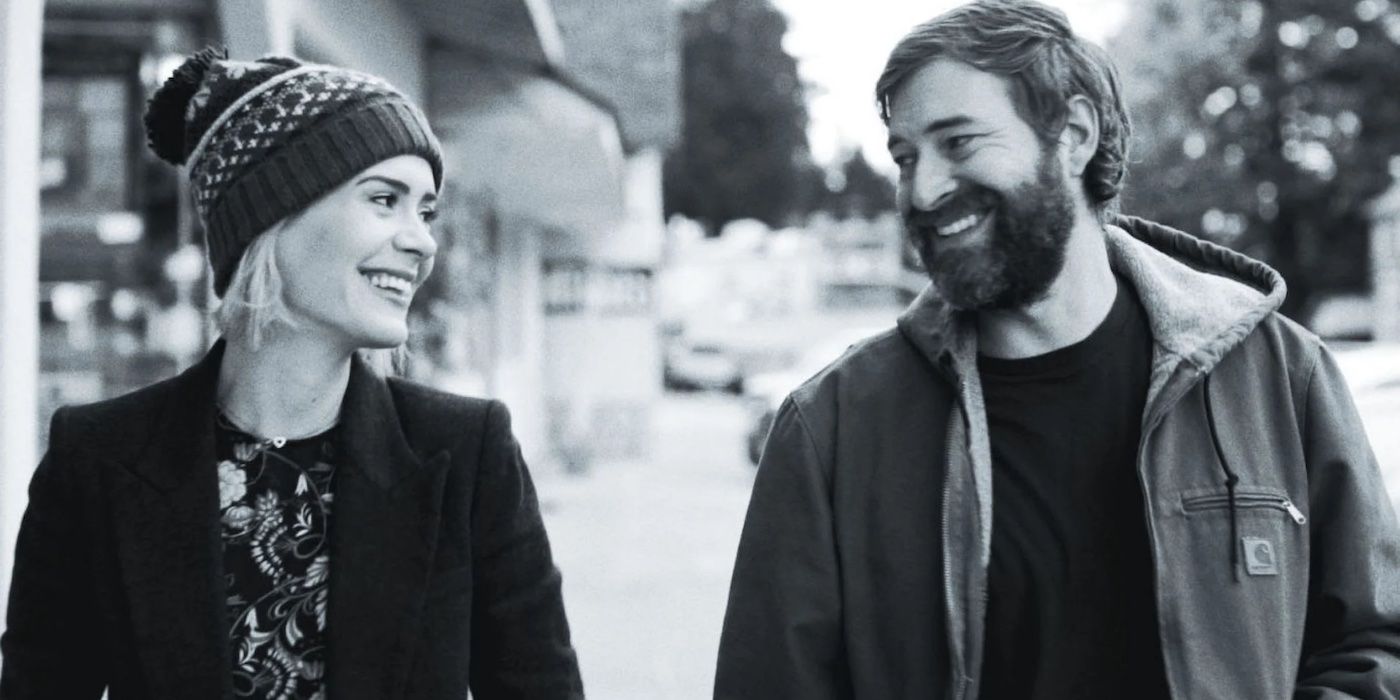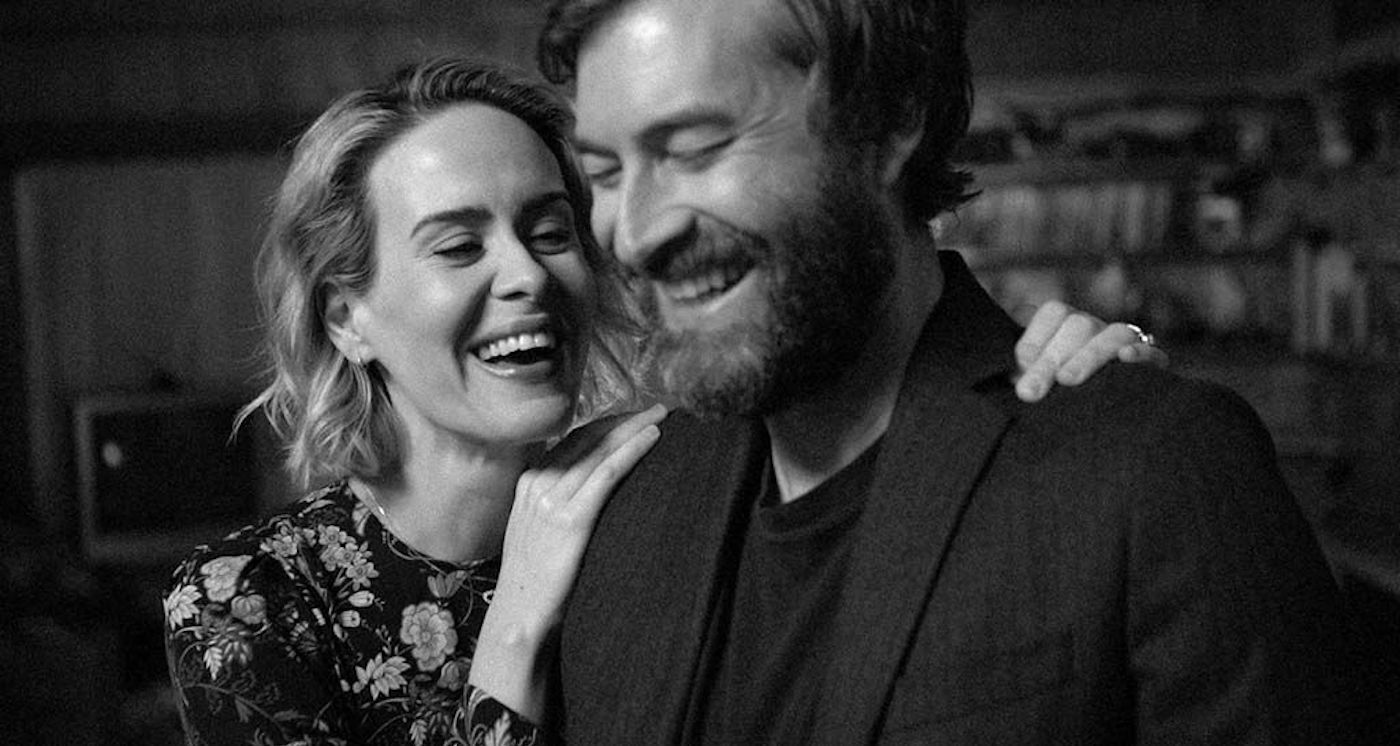Blue Jay is one of the simplest films ever made. For the bulk of its runtime, the film consists of just two characters, Jim and Amanda (Mark Duplass and Sarah Paulson, respectively), a pair of high school sweethearts who are reunited after twenty years apart. The film follows the former couple over the course of one day, starting with their chance reunion in a supermarket and ending with them going their separate ways again, with director Alex Lehmann stripping away everything that could distract from his central cast. There’s no action, no fancy cinematography, no moments that give any indication there’s anyone behind the camera controlling what we are seeing. Instead, we are treated to a series of delicate and artfully constructed scenes that explore the entire breadth of their relationship, all in a runtime that barely scrapes past the 80-minute mark.
Simplicity is a hard thing to pull off, with artists often falling into the trap of trying to achieve impressive techniques or colorful dialogue but Lehmann avoids this with flying colors. Rather than using his debut film to loudly announce himself as the new face of indie filmmaking, he instead chooses to keep his presence minimal in a decision that greatly benefits the end result. Blue Jay isn’t just one of the simplest films ever made, it’s also one of the most powerful.
From just a basic depiction of the plot, Blue Jay may appear to be nothing more than another comedy-drama that the entire world of indie filmmaking appears to cultivate like weeds in a garden. In some respects, it’s not an inaccurate statement. The concept of taking a group of talented but not A-list actors and putting them through the wringer of quirky comedy and miserable drama, all presented with a joyful (albeit slightly smug) sensibility that acts as though it's making a series of profound statements never before attempted in cinema, is something that countless films attempt every year. Blue Jay didn't reinvent the indie wheel the way Sex, Lies, and Videotapes or Dazed and Confused did, but nor is it trying to. Instead, Lehmann is more interested in just telling his story, proving that a simple plot well told is still the most effective form of storytelling there is.
What does set Blue Jay apart from the field, however, is its utterly stripped-back design. Everything is kept to a minimum, turning the film into a chamber piece that provides some of the most touching and emotional filmmaking of its era. The story plays out in only a handful of locations, all of which feel like entries on a most mundane places where scenes could occur list: a coffee shop, a convenience store, a house, etc. The latter forms the backdrop for the entirety of the film’s second half, a far cry from most films that like to provide a change of scenery at regular intervals to keep things fresh. Music is also used sparingly, and the little that is featured blends seamlessly into the background, providing a crucial leg to the film’s foundation that will ultimately go unnoticed by most viewers. There’s little variety in the scenes, with the majority focusing on Jim and Amanda’s conversations as they catch up on what the other has been doing, reminisce about their past together, and, as is inevitable in a film like this, the unfortunate reasons that led to them breaking up. There’s a lot of talking in Blue Jay, and with Lehmann resisting the temptation to add auxiliary elements even when it could have been justified by the narrative, those looking for something to break up the repetition will be sorely disappointed.
For example, in the twenty years since she and Jim were a couple, Amanda has gotten married and become the stepmother to two children. A lesser film would have taken this opportunity to show these characters, no doubt leading to some tense encounters between Jim and her husband that would have given the film a dramatic spark to keep the more casual viewer engaged. But Lehmann is smarter than that. Instead, he leaves them in the background where they belong, avoiding cliché scenes all romantic dramas fall victim to so as to keep the focus on the characters that matter. The only other character with dialogue is Waynie (Clu Gulager), the owner of a convenience store they used to frequent while they were a couple, and who delights in the fact (or so he thinks) that the “famous lovebirds” are still together after all these years.
It’s just a casual comment, but it plants a dangerous idea in their heads that continues to grow throughout the film, ultimately becoming the basis for the entire third act. Despite featuring in only one scene, Waynie plays a vital role in the film’s narrative, and his inclusion reveals Lehmann’s mastery of the situation even while keeping his presence hidden. Rather than stubbornly sticking to the mantra of only having two characters in the entire runtime (even if that may prove detrimental to the overall story), Lehmann shows he is willing to expand outwards if necessary. Waynie may only appear for one scene, but he’s a vital competent of the narrative whose subtle inclusion ensures he does not distract from the raw simplicity that defines the film.
One of the most striking aspects of Blue Jay is its black-and-white aesthetic. It’s the only aspect of the film that appears to contradict its stridden desire not to be noticed, but in reality, it feels like a decision made entirely to quell this concern. In his desire to give the film an unnoticeable style, the lack of color feels like Lehmann’s attempt to trim back the medium to its most basic elements, cutting every superfluous technique until only the essentials are left. While it’s impossible for viewers to miss the use of black and white during the film’s opening, by the time Jim and Amanda reunite it has already faded into the background. From this point on, it is just another method to keep the audience focused on what’s most important, and arguably proves to be the most effective of the lot.
Lehmann (who also served as cinematographer) deliberately avoids impressive shots with picturesque compositions, instead opting for a more restrained look that gives the impression of being improvised on the spot. It’s a decision that ensures Blue Jay will never join the ranks as one of the most visually arresting films ever made, but it’s clear that that was never Lehmann’s intention. Its cinematography is designed to fit the story and the method used in its telling, and given that most people will watch Blue Jay and never even consciously think of such things, it’s clear he succeeded in this respect.
For a film where 99% of its dialogue is spoken by just two characters, it’s no surprise that Blue Jay is a film that lives or dies on its actors. Thankfully, it excels in this area, with Mark Duplass and Sarah Paulson delivering the best performances of their careers. The chemistry between actors is a science filmmakers are still struggling to understand, but right from Jim and Amanda’s first scene, their eyes meeting across the condiment aisle in the local supermarket, there is no doubt that Duplass and Paulson are a match made in heaven.
Their chemistry together is simply flawless, with each bouncing off the other with such ease it is impossible not to see what brought them together twenty years ago. While much of this is conveyed in dialogue, Duplass and Paulson also pack their performances full of subtle details that elegantly reveal aspects of their characters that words never could. A half-smile here, a wishful gaze when the other person isn’t looking there, and so on. Taken on an individual basis, these details add little to the overall picture, but, collectively, they turn their respective characters into some of the most believable in all of film. Jim may be a middle-aged man with an ungroomed beard who has little to show for all the years he has lived, but the way Amanda looks at him as though he was made of solid gold is sure to warm anyone’s heart.
It also adds to the sad undertones that run throughout the film. With Jim and Amanda caring for each other so much, what could have caused them to break up? Blue Jay does provide an answer to this question in the only scene that sees Duplass and Paulson taking off the restraints to deliver louder and more temperamental performances that such films are seemingly obligated to include. However, the film has spent its entire runtime building up to this moment and watching these characters finally say everything they’ve been holding back on is not only a relief for them, but also for the audience.
Blue Jay is a film that celebrates the craft of acting, with everything Lehmann has done to ensure that the audience focuses on them and them alone. His approach may appear overly simple, but it’s during the film’s climax that all his hard work pays off. Since the viewer has had no choice but to indulge themselves in every aspect of these characters for the past hour, learning the painful reasons why they can never be together makes for some of the most heartbreaking footage in all of cinema. It’s powerful stuff, and would not have had close to the same level of impact had Lehmann flirted around with a more showy directing style or placed a greater emphasis on the film’s supporting cast. Instead, he narrowed his vision and focused on what mattered, and the results speak for themselves.
Alex Lehmann clearly has an interest in the simpler things. He followed up Blue Jay with 2019’s Paddleton, another comedy-drama starring Mark Duplass that again opted for the less is more approach with its filmmaking. The result was another quietly tragic film, albeit one that felt a touch more conventional than its predecessor as Lehmann went for a larger narrative with an expanded cast of characters. It certainly made for another solid entry in his increasingly impressive filmography, but it lacked the intimacy that made Blue Jay such a success. That film remains a delight six years on from its release. It's the antithesis of a typical Hollywood blockbuster that would never dare to include such quiet and tender moments if there wasn’t something louder just around the corner, let alone construct its entire narrative around nothing but such moments. While directors should always be willing to try something new, the mastery with which he pulled off his debut is something he should not forget. Blue Jay is a pleasant reminder that the simplest stories are often the best, and with a runtime on par with the average length of an episode of television these days, there’s no excuse not to watch it.

